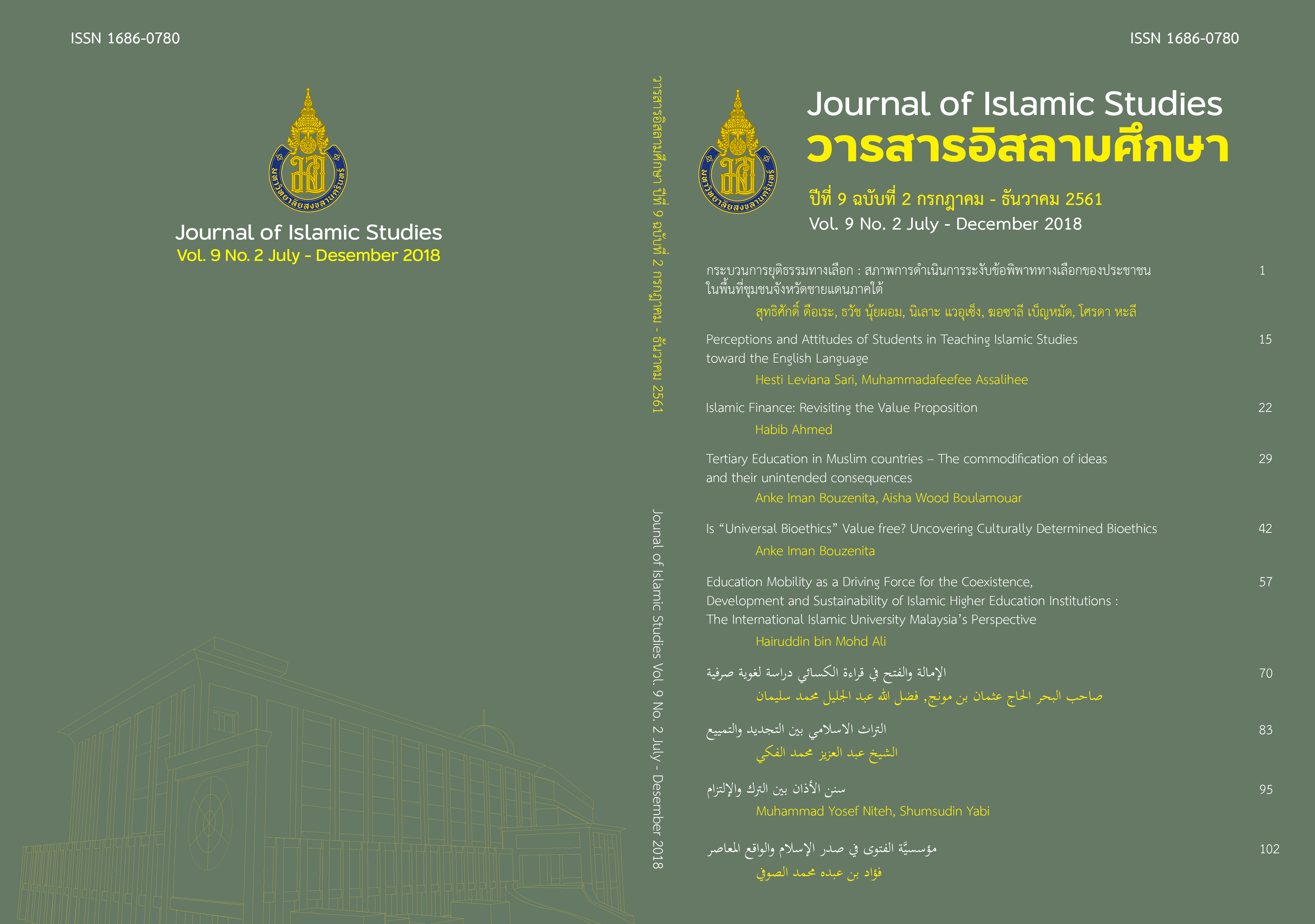Innovative Financing Options for Islamic Microfinance Institutions
คำสำคัญ:
Sources, Funds, Islamic Microfinanceบทคัดย่อ
Islamic microfinance in this contemporary era requires to be supported in many countries at global level particularly in Indonesia, Bangladesh and Afghanistan. However, the issue of sources of funding of Islamic microfinance institutions has been a major challenge. This paper attempts to tackle this issue of liquidity shortage of financing the institutions. The paper finds that there are two main sources of funds which might be viable and vibrant financing instruments for the Islamic microfinance institutions. These sources of funds include internal and external sources of funds. This paper is unique in its context and might be helpful to the sustainability of Islamic microfinance institutions. Furthermore, it might play a significant role to facilitate more efficient liquidity management paradigm and increase the funds size of the Islamic microfinance institutions.
เอกสารอ้างอิง
Abdul Rahman, Rashidah & Dean, Faisal. (2013). Challenges and solutions in Islamic microfinance. Humanomics. 29(4), 293-306.
Abu Malik, Kamil bn Sai'd Salim. (n.d). Sahih Fiqh as-Sunnah Wa-Aadilatih Wa-Tawdih Madhahib al-Arba'ah. (vol. 2). al-Maktabah at-Tawqifiyyah.
Ahmed, Habib. (2007). Waqf-Based Microfinance: Realizing the Social Role of Islamic Finance. Paper presented for International Seminar on Integrating Awqaf in the Islamic Financial Sector, Singapore, March 6-7, 2007.1-22
Ali, Khadija. (2013). Islamic Microfinance in Pakistan: The Experience so Far. http://www.cgap.org/blog/islamic-microfinance-pakistan-experience-so-far.
Alshebami, A. S., & Khandare, D. M (2015), Islamic Microfinance Industry in Yemen “Challenges and Opportunities.” International Journal of Social Work, 2(2), 15-23.
Ayub, Muhammad. (2009). Understanding Islamic Finance. England: John Wiley & Sons.
Bin Abdullah, Mohamad Asmadi. (2012). The Entitlement of the Bayt Al-Mal to a Muslim Praepositus’ Estates; an Analysis on the Right of a Muslim to Bequeath without Obtaining a Consent from the Bayt Al-Mal. International Journal of Social Sciences and Humanity Studies. 4 (1), 269-278.
Buang, Ahmad Hidayat. (2000). Studies in the Islamic Law of Contracts: The Prohibition of Gharar. Kuala Lumpur: International Law Book Services.
Chammas, Ghassan. (2006). Islamic Finance Industry in Lebanon: Horizons, Enhancements and Projections. Retrieved from: https://www.salaamgateway.com/ar/story/islamic_ finance_industry_in_lebanon_horizons_enhancements_and_projections-salaam170120 17063440/ Retrived from: http://pdf.usaid.gov/ pdf_docs/PA00HPHF.pdf.
Choudhury, Masudul Alam & Dusuki, Asyraf Wajdi. (2008). Banking for the Poor: The Role of Islamic Banking in Microfinance Initiatives. Humanomics. 24(1), 49-66.
Dusuki, Asyraf Wajdi. (2008). Banking for the Poor: The Role of Islamic Banking in Microfinance Initiatives. Humanomics. 24(1), 49-66.
_____.(2011). Islamic Financial System: Principles & Operations. Kuala Lumpur: International Shari’ah Research Academic for Islamic Finance (ISRA).
_____,& Abdullah, Nurdinawati Irwarni. (2011). Fundamentals of Islamic Banking. Kuala Lumpur: IBFIM.
Eisenberg, David. (2012). Islamic Finance: Law and Practice. United Kingdom: Oxford University Press.
Al-Faqi, Muhammad 'Abdu al-Haid. (2010). al-Ada' al-Iqtisadi Lil-Masarif al-Islamiyyah Wa-Atharuh Fi 'Amaliyyah at-Tanmiyyah al-Iqtisadiyyah: Dirasah Fiqhiyyah Iqtisadiyyah. Cairo: 'Alam al-Kutub
Hamzah, Zaid. (2011). Islamic Private Equity and Venture Capital : Principles and Practice Kuala lumpur: Islamic Banking and Finance Institute Malaysia.
Husain, Ahmad Faraj. (2003). Ahkam Al-Wasaya Wa Al-Awqaf Fi Al-Shari’ah Al-Islamiyyah . Alexandria: Dar Al-Jami’ah Al-Jadtdah Li-Nashir.
Al-Haj, Tariq. (2010). Mabadi’ at-Tamwil. 1sted., ‘Uman: Dar Maf’ Li-Nashrwat-Tawzi’.
Ibn Hajar. (2003). Fat’h al-Bari Sharh Sahih al-Bukhari. (vol.1-5). Maktabah Salafiyah.
Ibrahim Bik, Ahmad. (1936). al-Mu'amalat ash-Shari'iyyah al-Maliyyah. Cairo: Dar al-Ansar.
Islamic Development Bank. (2013). Progress Report of the Activities of Islamic Solidarity Fund for Development (ISFD). Retrieved from: http://www.comcec.org/wp-content/uploads/2015/02/ Latest_progress_report_on_ISFD_May_2013.pdf.
Islamic Development Bank Group. (2013). Islamic Development Bank Group in Brief. Retrieved from: http://www.isdb.org/irj/go/km/docs/documents/IDBDevelopments/ Internet/ English/IDB/CM/Publications/IDBGroupBrief2013.pdf.
______, & Islamic Financial Services Board. (2007). Islamic Financial Services Industry Development: Ten-Year Framework and Strategies. Retrieved from: https://islamicmarkets.com/publications/islamic-financial-services-industry- development-ten-year-framework-and-strategies.
Islamic Research and Training Institute. (2016, June 28). Islamic Financial Services Industry Development: Ten-Year Framework and Strategies. Retrieved from: http://www.ifsb. org/docs/10_yr_framework.pdf;
Maatallah, Magid. (2011). Principles of Islamic Finance Riba and Murabaha. U.S.A.: LAP LAMBERT Academic Publishing.
Manzur, Davood; Meisami, Hossin & Roayaee, Mehdi. (2013). Banking for the Poor in the Context of Islamic Banking and Finance. Journal of Contemporary Management. 2(2), 1-53.
Md Saad, Norma. (2012). Microfinance and Prospect for Islamic Microfinance Products: The Case of Amanah Ikhtiar Malaysia. Advances in Asian Social Science. 1(1), 27-33.
Mohd. Yatim, Mohd. Nasir & Mohd Nasir, Amirul Hafiz. (2008). The Principles and Practice of Islamic Banking & Finance. Pearson Malaysia.
Nimrah, Karim, Michael, Tarazi, & Xavier, Reille. (2013, October 19 ). Islamic microfinance: An emerging market niche. Retrieved from: http://sitesources. World bank.org /EXTDEVDIALOGUE /Sources/5372971241045572558/Islamic Micro Finance.pdf
Pock, Alexander Von . (2007). Strategic Management in Islamic Finance . Germani: Springer Science & Business Media
Possumah, Bayu Taufiq & Baharuddin, Gunawan. (1012). Governing Baitul Mal towards 2020; Issues and Challenges: Indonesia Experiences. International Jounal of Bussiness and Management Tomorrow. 2(10), 1-10
Obaidullah, Mohammed. (2008). Introduction to Islamic Microfinance. India: IBF Net (P) Limited.
______, & Khan, Tariqullah. (2008). Islamic microfinance development: Challenges and initiatives. Jeddah: Islamic Development Bank.
Overy L L P & Allen. (2009). Islamic Microfinance Report. International Development Law Organization. 1-28.
Al-Qardawi, Yusuf. (1999). Fiqh Az-Zakah: A Comparative Study, the Rules, Regulations of the Qur’an and Sunah. London: Dar at-Taqwa.
Al-Qurawi, Muahammad Al-'Arabi. (2006). al-Khulasah al-Fiqhiyyah 'Ala Madhahib as-Sadah al-Malikiyyah. Beirut: Dar al-Kutub al-'Ilmiyyah.
Siddiqi, S. A . (2007). Public Finance in Islam. New Delhi: Adam Publishers & Distributors.
Tamanni, Luqyan, Zouari, Zeineb & Nabi, Mahmoud Sami. (2014, January). Islamic Microfinance. Global Islamic Finance Report 2014. 162-173. Doi:: 10.13140/RG.2.1.4750.6960.
Usmani, Muhammad Taqi. (2002). An Introduction to Islamic Finance. Netherland: Kluwer law International.
Wasil Foundation. (2016, June 26). Retrived from: http://wasil.org.pk/home.aspx.
Wilson, Rodney. (2007). Making Development Assistance Sustainable through Islamic Microfinance. International Journal of Economics, Management and Accounting. 15(2), 210–211.
Yaqub, Waseem. (2006). Waqf Future Fund Working towards a Better Future. Retrieved from: http://www.irwaqf.org/wp-content/uploads/ 2014/10/WAQF _A4.pdf
Yumna, Aimatul and Matthew Clarke. (2011). “Integrating Zakat and Islamic Charities with Microfinance Initiative in the Purpose of Poverty Alleviation in Indonesia,” in Proceeding 8th International Conference on Islamic Economics and Finance, Center for Islamic Economics and Finance, Qatar Faculty of Islamic Studies, Qatar Foundation.
ดาวน์โหลด
เผยแพร่แล้ว
รูปแบบการอ้างอิง
ฉบับ
ประเภทบทความ
สัญญาอนุญาต
บทความทุกเรื่อง ที่ได้รับการตีพิมพ์ในวารสารอิสลามศึกษาเป็นแนวคิดของผู้เขียน มิใช่เป็นความคิดเห็นคณะผู้จัดทำและมิใช่ความรับผิดชอบของคณะวิทยาการอิสลาม กองบรรณาธิการไม่สงวนสิทธิ์การคัดลอก แต่ให้มีการอ้างอิงแสดงที่มา




